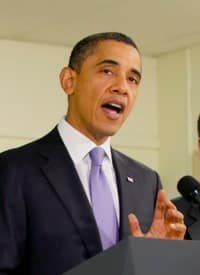
Item: An Education Weekblog for February 14, in a piece entitled “Obama Proposes Modest Hike in Education Spending for FY 2012,” reported that “education is a bright spot in an otherwise tight budget.” The “Politics K-12” blog took note of President Obama’s visit that day to a school in Baltimore County, Maryland. The President said “that while he recognizes the need to rein in federal spending, ‘we can’t sacrifice our future in the process. That’s especially true when it comes to education.’”
Item: A USA Today article for February 15 discussed the education component of the newly proposed budget “that administration officials portrayed as austere.” Education was given a special privileged status, “though not without some potential pain for programs important to colleges and students.” Many priorities “for higher education would take a meaningful hit.”
“Higher education leaders and advocates for students,” noted Doug Lederman of USA Today, “typically howl in protest when political leaders of any party of political persuasion threaten programs dear to them, and they did not hide their disappointment with the president’s proposed cuts Monday.”
The paper went on to say: “Unlike House Republican leaders, who in their first crack at a Tea Party-friendly federal budget plan cut disproportionately from health, education and labor programs, President Obama’s 2012 budget blueprint generally shields what he calls ‘investments’ in education, research and a few other key areas in an overall budget that begins a five-year drive to freeze most federal spending and reduce the deficit.” The administration’s proposal “would sustain” the “vast majority” of Education Department programs “for students and colleges at their 2010 levels.”
Item:The front-page headline of the main story of the Washington Post for January 15 declared: “Obama budget makes deep cuts, cautious trades.”
Correction:You need a microscope to pick out any cuts in the Obama budget, while the increases, far more numerous, are Brobdingnagian.
The White House put the Education Department down for almost 21 percent more in fiscal 2012 than in 2010 (there was no budget passed for fiscal 2011). While you can find such information in the Washington Post, you have to read the fine print well inside the paper that misrepresents the “deep cuts” on page one. The Post neglected to point out that, although the President has promised deficit reductions, just about two-thirds of what is pledged doesn’t happen until after 2016. In general, liberal media coverage would have one believe the President was widely chopping but perhaps only trimming in the education area in an exercise of fiscal restraint. “Obama Plan Aims to Rein In Deficit,” for example, read the headline in the Fort Worth Star-Telegram.
Well, if that really is the aim, the President isn’t much of a straight-shooter.
Other media outlets were even more effusive about the White House education blueprint. One national paper headlined its coverage, “Teachers and students support Obama’s education budget.” It cited the backing of the American Federation of Teachers and the United States Student Association, which supported the budget “as a sign of the administration’s commitment to public schools and higher education.” The White House Press Secretary didn’t trumpet that headline, though, likely because that’s the take of People’s World, the organ of the Communist Party.
In reality, the supposed overall budget savings, as the Wall Street Journal did observe, “are so far off in the magical ‘out years’ that you can barely see them from here. More than 95% of the savings would happen after Mr. Obama’s first term in the White House is over.”
Cuts, such as they are, were generally proposed in only the “discretionary” non-defense spending area — even there, cuts were usually snips in the projected rates of growth, resulting in smaller percentages of what is expected to be a fast-growing GDP. Many in the mainstream media echo the vocabulary of Washingtonese, which is meant to conceal rather than to reveal, so that smaller increases than previously planned are often termed “cuts.”
However, it helps to have a real cut or two, if only for cover. Consider the Pell grant program for higher education, which has exploded in costs, particularly in just the last two years. It faces a $20 billion deficit by the end of next year. The administration’s education budget actually did take out the tweezers and trim a relatively new part of the Pell program that was effectively allowing some students to get “two Pells” in a given year. Education Secretary Arne Duncan acknowledged that that move turned out to be 10 times costlier than expected, to the tune of budget numbers “in the multiple billions” of dollars. So that recent increase really did get nicked, backed to what it was before. On the other hand, the administration is resisting some relatively minor cutbacks that the GOP has proposed for maximum Pell grants.
Typical of the administration’s stance is its version of New Math, which resorts to budget trickery about what it is really doing. As the Heritage Foundation observed, the White House could only lay claim to a supposed reduction of certain so-called discretionary spending by changing the rules, including “redefining” Pell grants “as mandatory spending.” “Stripped of this gimmick, discretionary spending jumps by $14 billion in 2012,” pointed out economist J.D. Foster.
Have you gotten a 21-percent raise since 2010? If so, one assumes you earned it through higher productivity and that your employer is doing well. Federal educrats need not worry about such mundane matters since the taxpayers are fleeced to fund their department regardless of results or recession.
Setting aside the fact that education is not, constitutionally, a federal matter, but one for the states and localities, how successful has the federal government’s supposed help really been? The President’s budget, after all, says in the education section, “Now more than ever, we cannot waste taxpayer dollars on programs that do not work.”
So, let’s look at costs and benefits as if federal aid really does represent an “investment” in a business, as Obama contends. Let’s go back four decades to when federal involvement became significant. This was covered in recent testimony before the House Education and Workforce Committee. As noted by Andrew Coulson, director of the Cato Institute’s Center for Educational Freedom:
We spent over $151,000 per student sending the graduating class of 2009 through public schools. That is nearly three times as much as we spent on the graduating class of 1970, adjusting for inflation. Despite that massive real spending increase, overall achievement has stagnated or declined, depending on the subject…. We have little to show for the $2 trillion in federal education spending of the past half century. In the face of concerted and unflagging efforts by Congress and the states, public schooling has suffered a massive productivity collapse — it now costs three times as much to provide essentially the same education as we provided in 1970.
Seen in that proper context, we would have to be disappointed with our nation’s lack of educational improvement even if federal spending had not increased at all. The fact that outcomes have remained flat or declined while spending skyrocketed is a disaster unparalleled in any other field.
Even when the feds themselves discover a program doesn’t work, it seems to have little bearing on funding. A federal evaluation of the Head Start program, which is supposed to provide “disadvantaged” children with an early pre-school boost, was released in 2010. It demonstrated that the program is, at best, ineffective.
The results of the Head Start Impact Study have been summarized by David Muhlhausen of the Heritage Foundation:
For the four-year old group, compared to similarly situated children not allowed access to Head Start, access to the program failed to raise the cognitive abilities of participants on 41 measures. Specifically, the language skills, literacy, math skills, and school performance of the participating children failed to improve.
Alarmingly, access to Head Start for the three-year-old group actually had a harmful effect on the teacher-assessed math ability of these children once they entered kindergarten. Teachers reported that non-participating children were more prepared in math skills than those children who participated in Head Start.
This abysmal performance, keep in mind, was revealed at a time when the economy was tanking and folks nationwide certainly didn’t have funds to spare. That was also, of course, when the Obama administration was chucking another $100 billion at the Education Department in federal “stimulus” spending.
Back to the Heritage rundown on Head Start’s achievement, or lack thereof:
Also, Head Start has little to no effect on the other socio-emotional, health, and parenting outcomes of children participating in the program. For the four-year-old group, access to Head Start failed to have an effect for 70 out of 71 socio-emotional, health, and parenting outcomes. The three-year-old group did slightly better; access to Head Start failed to have an effect for 66 of the 71 socio-emotional, health, and parenting outcomes.
So what has been the administration’s response? The latest budget calls for an increase in Head Start funding, to $8.1 billion compared to $7.2 billion in FY 2010.
When you reward failure, you get more of it. And don’t think that there aren’t those who wouldn’t like Uncle Sam to get his hands on our children at even younger ages. U.S. Senator Bernie Sanders, the Independent socialist from Vermont, has just introduced a bill to provide “child care and early education to all children six weeks old through kindergarten.” (Emphasis added.)
Says Sanders of his Foundations for Success Act: “The best way to both address our educational shortcomings and strengthen our economy over the long term is to invest in our children as early as we possibly can.” The way the statist clichés roll off the Senator’s tongue serves as a reminder: When some politicians act foolishly, they aren’t acting.
As it is, our continuing subsidization of poor performance is adding up to a very hefty sum. Recent figures indicate that Washington is throwing somewhere in the neighborhood of $120 billion a year at “education,” including K-12, higher education, and student loans. All of this has led to a marked increase in the numbers of those receiving monies, a great many of whom are not teachers.
Citing figures from the Digest of Education Statistics, Neal McCluskey has summarized the federal gusher in the Daily Caller: “On a per-pupil basis, in 1970 the feds spent $435 per student. By 2006 — the latest year with available data — it was $1,015, a 133 percent increase. And it’s not like state and local spending was dropping: Real, overall, per-pupil spending rose from $5,593 in 1970 to $12,463 in 2006, and today we beat almost every other industrialized nation in education funding.”
What have been the results? Essentially, we are paying more and getting less. Writes McCluskey:
Certainly more public school employees: Between 1969 and 2007, pupil-to-staff ratios were close to halved. Not coincidentally, these same people politick powerfully for ever more spending and against reforms that will challenge their bloated monopoly. They also routinely defeat efforts to hold them accountable for results.
This constant feeding of special interests is why we’ve gotten zilch in the outcome that really matters — learning. Since the early 1970s, scores on the National Assessment of Educational Progress — the “Nation’s Report Card” — have been utterly stagnant for 17-year-olds, our schools’ “final products.” In 1973 the average math score was 304 (out of 500). In 2008 it was just 306. In reading, the 1971 average was 285. In 2008 it was up a single point, hitting 286.
The higher education tale is much the same, especially for student aid, the primary college dumping ground for federal dollars. According to the College Board, in 1971 Washington provided $3,814 in inflation-adjusted aid per full-time equivalent student. By 2009-10 that figure had more than tripled, hitting $12,894.
By most available indicators this has been money down the drain. For instance, only about 58 percent of bachelor’s seekers finish their programs within six years, if at all. Literacy levels among people with degrees are low and falling. And colleges have raised their prices at astronomical rates to capture ever-growing aid.
It starts at the top. In February, on the day that his budget was announced, the President told schoolchildren in Maryland that the only way to “win the future” — his new pet phrase — is to ensure that “every American is equipped to compete with any worker, anywhere in the world.” And, said Obama, the only way to do that “is if our government starts living within its means, if we start taking responsibility for our deficits.”
Anyone can get lost in a fog. Some create their own.
Photo: AP Images



